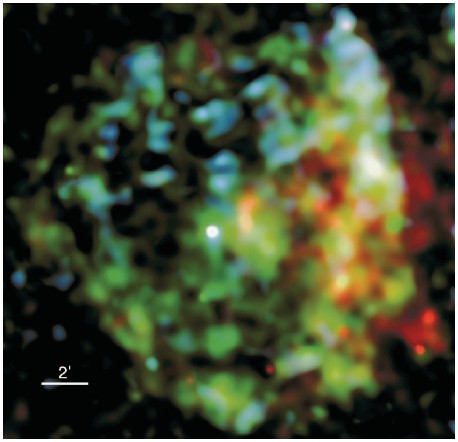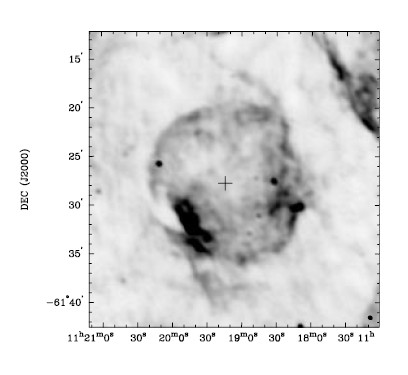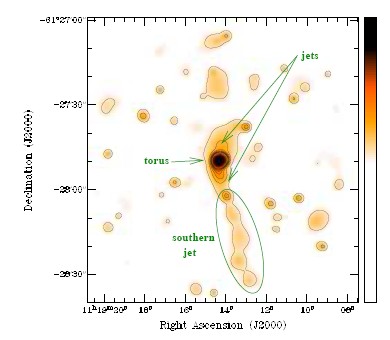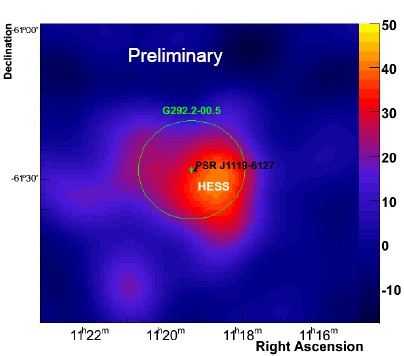Discovery of VHE Gamma-Ray Emission of a Remarkable Young Composite SNR
November 2009

The high rate of change of the rotation period, however, points to a rapid loss of rotational energy caused by the high magnetic field of 4.1 x 10^13 Gauss, The pulsar PSR J1119-6127 was discovered in 1997 in a survey of the Galactic plane using the Parkes radio telescope in Australia (Camilo et al. 2000). This pulsar is characterized by an unusually high surface magnetic field of 4.1 x 10^13 Gauss, similar to the pulsar PSR J1846-0258 (Kes 75) - another VHE gamma ray source - and among the highest field strengths yet observed among young and energetic radio pulsars, intermediate between 'normal' pulsars and magnetars. The large magnetic field combined with the - relatively normal - rotation period of 0.4 sec results in a high loss rate of rotational energy. The age since birth of the pulsar is estimated to less than 1700 years. In observations with the ATCA radio telescope array, Crawford et al. (2001) discovered a 15 arcminute diameter supernova shell (Fig. 1), labeled SNR G292.2-0.5., and presumably resulting from the stellar explosion in which the pulsar was born. The distance to pulsar and shell were estimated to about 5 kpc, with very large uncertainty, implying a diameter of the shell of order 10 pc and age of the shell of a few 1000 years, compatible with the estimated age of the pulsar. X-ray emission from the pulsar was first reported by Pivovaroff et al. (2001) using archival ROSAT data and ASCA data, but it required high-resolution imaging using Chandra to resolve the X-ray nebula surrounding the pulsar (Gonzales & Safi-Harb 2003) and to discover the jet-like structures emerging from the pulsar (Fig. 2)(Safi-Harb & Kumar (2008)). Similar jet-like features are seen near many pulsars, including the Crab pulsar. The supernova shell is also nicely seen in the XMM-Newton X-ray data of Gonzalez et al. (2005) (top image), in which for the first time pulsed X-ray emission was detected.
The large loss of rotational energy of the pulsar, a few 10^36 ergs/s, makes this composite supernova remnant an interesting target for observations with H.E.S.S., and indeed hints for a very high energy gamma ray signal were seen in data of the H.E.S.S. Galactic Plane Survey. In follow-up observations for a total observation time of about 50 h, a TeV gamma-ray source coincident with PSR J1119-6127 and G292.2-0.5 was confirmed (Fig. 3). The emission region is extended compared to the point spread function of H.E.S.S., and the flux is about 4% of the flux from the Crab nebula. The centroid of the emission is offset from the pulsar in the West/South-West direction, overlapping with a region of increased X-ray emission from the shell (top image), which might be attributed to interaction of the supernova shock with ambient material, or both. The origin of the TeV emission is not yet uniquely identified; it could either be attributed to an offset pulsar wind nebula as seen for many pulsars, or to particles accelerated in the shell and interacting with ambient gas.
Reference: A. Djannati-Atai et al., H.E.S.S. Collaboration, "HESS discovery of VHE gamma-ray emission of a remarkable young composite SNR", Talk at the Workshop "Supernova Remnants and Pulsar Wind Nebulae in the Chandra Era", 2009


